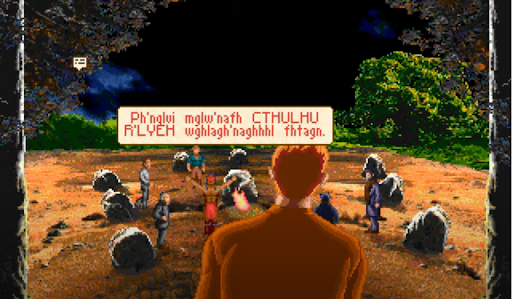Developer: Infogrames
Publisher: Infogrames
Systems: DOS
Year of release: 1993
Genre: Point and Click Adventure
TCU Archive Access: Yes- available for play in Fab Lab
Outside Access: Available for retail purchase
Time period: 1910
Location: Massachusetts
Tribe: Fictional- Mic Mac (fictional, but clearly alluding to a real tribe: Mi’kmaq)
Character Types: Non-player Character (villain), Non-player Character (friendly)
“That’s the Stone Circle. The location of the MIC MAC burial ground. And you say you know nothing of Indian culture?”
– Mr. Underwood
The leader and last surviving member of the fictional Mic Mac tribe, Narackamous, is ostensibly the villain for the majority of the first portion of the game. A long cut scene roughly two thirds of the way through the game gives some background on this imagined tribe and its connections to Cthulhu. In this way, the game does briefly address the worldview and values of this fictional tribe (though, through their connection to cosmic horrors, they are presented as evil and inhumane). The player also meets Natawanga, who acts as a sort of foil to Narackamous. Natawanga’s tribal affiliation is not named, but he lives alone in the forest and offers the player magical assistance in their journey to stop the emergence of Cthulhu. Players learn about Narackamous and the Mic Mac through brief encounters with the villain himself and via journals and dialogue with the townspeople in Illsmouth. Many of these interactions depict overt racism toward the Mic Mac people.
Call of Cthulhu: Shadow of the Comet is a point and click adventure game inspired by H.P. Lovecraft’s Cthulhu mythos. While not a direct interpretation of any particular story, the game has strong elements of two different Lovecraft stories. The name of the town most of the game takes place in, Illsmouth, is a clear reference to Innsmouth, a town featured in Lovecraft’s “The Shadows over Innsmouth”. Several plot points involving the major families in Illsmouth are clear references to Lovecraft’s “The Dunwich Horror”. Players take on the role of John Parker, a journalist investigating mysteries surrounding the arrival of Halley’s comet. The game takes place over three consecutive days, from Parker’s arrival in Illsmouth to the appearance of the comet on the final day.

The main villain of the game, Narackamous, is described the last remaining member of the fictional Mic Mac tribe. While the Mic Mac are made up, the Mi’kmaq are a real tribe who once occupied lands as far north as Nova Scotia in Canada and ranging at the southern end to the general area the game is set in (Massachusetts). The actual tribe’s name translates roughly to “family”, while in the game Mic Mac is said to mean “They who worship the Night Howler” (referring to Nyarlathotep- a deity Lovecraft created in his Cthulhu mythos). Despite being the primary antagonist, fairly little attention is given to his character in any of the reviews or contemporary information on the game.
Narackamous worships Cthulhu and is said to be summoning him to our planet. His use of dark sorcery and connection to the Elder Gods have given him supernatural powers. He is first seen in the introductory cut scene of the game, set during the 1835 appearance of Halley’s comet. He intermittently appears throughout the current events of the game, some 75 years later. He is also seen to teleport and alleged to have mysterious powers. He is one of the final boss fights in the game.

Natawanga tests the player before offering his assistanceThe game contains one other Native American character, Natawanga. Natawanga’s tribe is not mentioned, but as Narackamous is described as the last of his kind we can assume that he is not a Mic Mac. Toward the end of the game players are told that only Natawanga can give them the guidance necessary to defeat Narackamous. They must find sacred items and use them to locate Natawanga’s forest retreat. After passing a test, Natawanga gives the player the final information they will need to find Narackamous and destroy him (including some magical abilities).
As a point and click adventure, the game is mechanically very simple. Players navigate two dimensional screens, click on objects in the world for information and clues, and navigate dialogue trees (select from a list of conversational responses) with townsfolk to progress the story. While there is relatively little manual dexterity required for the game, many of the puzzles can be opaque. Contemporary gamers, particularly those not familiar with the point and click adventure genre, may struggle to complete the game without following a guide. Both written walkthroughs and video let’s plays are available. The game takes roughly four hours to complete.

- PC Zone, a UK-based computer magazine, published a preview for the game in its first issue. Though brief, it uses a picture of Narackamous.
- Hard Core Gaming 101’s review, coming almost twenty years after the game’s initial release, provides more substantial details both on the gameplay and the technology.
- Computer Gaming World’s review, published in Issue 109 of the American magazine, provides additional information on the game’s development.
To our knowledge, there are no scholarly sources extensively citing Call of Cthulhu: Shadow of the Comet. It is briefly mentioned in Horror Video Games: Essays on the Fusion of Fear and Play. However, as a game based in Lovecraft, researchers may be interested in consulting sources on Lovecraft’s works.
Gameplay videos are forthcoming.
